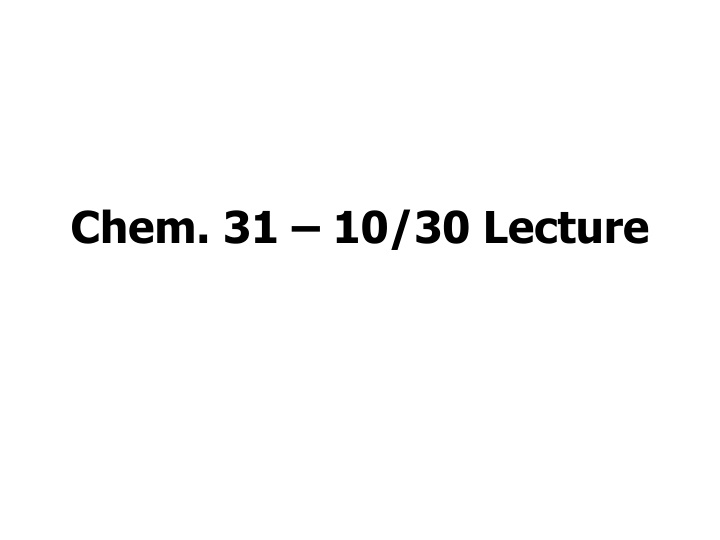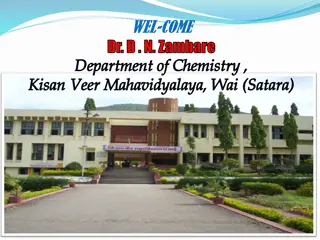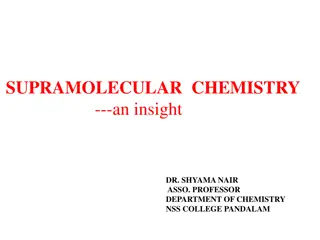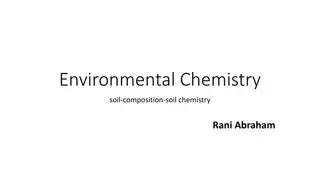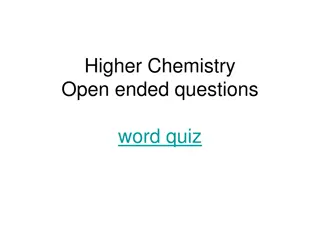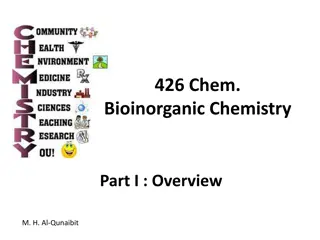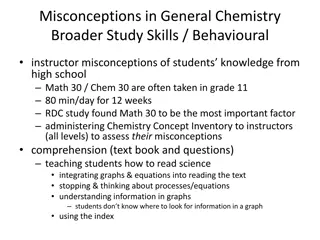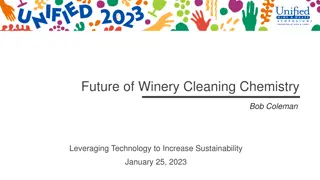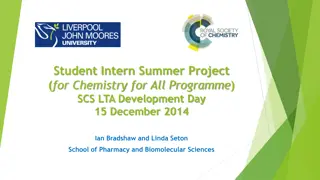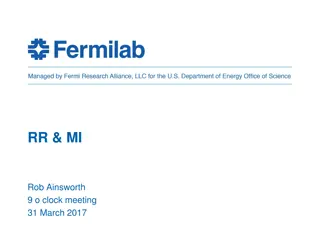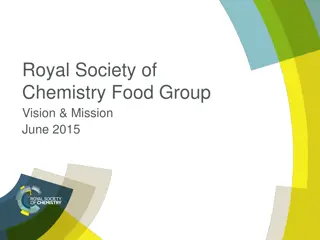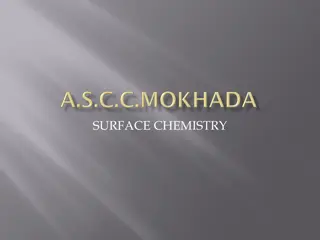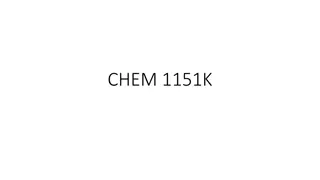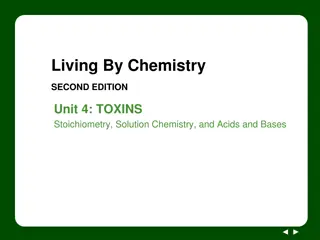Chemistry Lecture on 31st October - Understanding the Key Concepts
Delve into the immersive world of chemistry with this lecture on October 31st. Explore fundamental concepts, engage in stimulating discussions, and gain a deeper understanding of the principles that govern the natural world. Whether you're a seasoned chemist or a curious learner, this lecture promises to enrich your knowledge and inspire your scientific journey. Join us for an enlightening session that will challenge your intellect and ignite your passion for chemistry.
Download Presentation

Please find below an Image/Link to download the presentation.
The content on the website is provided AS IS for your information and personal use only. It may not be sold, licensed, or shared on other websites without obtaining consent from the author.If you encounter any issues during the download, it is possible that the publisher has removed the file from their server.
You are allowed to download the files provided on this website for personal or commercial use, subject to the condition that they are used lawfully. All files are the property of their respective owners.
The content on the website is provided AS IS for your information and personal use only. It may not be sold, licensed, or shared on other websites without obtaining consent from the author.
E N D
Presentation Transcript
Announcements I AA Lab Due today Quiz 4 On Wednesday On Acids part of Ch. 6/Chapter 7 materials/Chapter 18 materials (extractions) Today s Lecture Chapter 18 Spectroscopy Beer s Law Spectrometers
Announcements II Today s Lecture cont. Chapter 23 Chromatography Overview Partitioning (in extractions and chromatography) Chromatographs Transport (if time)
Spectroscopy Beer s Law Transmittance = T = P/Po Absorbance = A = -logT sample in cuvette Light source Absorbance used because it is proportional to concentration Light intensity in = Po Light intensity out = P A = bC b Where = molar absorptivity and b = path length (usually in cm) and C = concentration (M) = constant for given compound at specific value
Spectroscopy Beer s Law Question Half of the 284 nm light is absorbed when benzoic acid at a concentration of 0.0080 M is in a cuvette with a path length of 0.50 cm. What is the molar absorptivity of benzoic acid at this wavelength?
Spectroscopy More on Beer s Law Useful for determination of analyte concentrations Some limitations Law not valid for high concentrations Deviations to law appear to occur when multiple wavelengths of light used or when multiple species exist but absorb light differently Uncertainties are lowest when 0.1 < A < 1 Example of deviations to Beer s Law: Unbuffered Indicator with (In-) = 300 M- 1 cm-1, (HIn) = 20 M-1 cm-1; pKa = 4.0 HIn H+ + In- 0.5 0.45 0.4 0.35 Absorbance 0.3 0.25 0.2 0.15 0.1 0.05 0 0 0.005 0.01 0.015 Total HIn Conc.
Spectroscopy Spectrometers light detector measures light intensity by converting it to an electrical signal sample in cuvette Data processor light source light discriminator: monochromator (passes only a small range of wavelengths) Components can look very different in different types of spectrometers, but spectrometers will have all of the major components (except other methods of wavelength discrimination may replace monochromators)
Spectroscopy Example Measurement: Ozone Ozone (O3) is a pollutant (lower atmosphere) and in stratosphere provides UV protection Instrument is used for measurement at station or in airplane compares absorbance through sample cell vs. absorbance through reference cell Can also make measurements remotely (e.g. absorbance between two skyscrapers) light source ( = 254 nm) chopper air in reference cell sample cell O3 scrubber light detector
Chromatography Ch. 23 Introduction Purpose of Chromatography To separate and detect components of a mixture Analytical chemists are more interested in the detection part Advantages of Chromatography Can handle more complex samples than typical spectroscopic methods Also results in purification of mixtures (if desired) Disadvantage of Chromatography Separation takes time (so generally not as fast as pure spectroscopic methods) Basis for Separation: differential partitioning between a stationary and a mobile phase
Chromatography Partitioning Ch. 23 Sect. 1 Covering to understand partitioning in chromatography Partitioning can occur between any two phases (as long as one phase is a fluid) Liquid-liquid is chosen as an example Partitioning governed by equilibrium equation X(org) X(aq) [ ] X [ K = partition coefficient (a constant) org ] = K X aq note: technically, upper conc. is for raffinate phase while lower is for extractant phase
Chromatography Partitioning Other Effects on Partitioning K gives distribution if compound does not react further in either phase However, compounds may react further (e.g. acid HA H+ + A- in aqueous phase) Ions (e.g. A-) will be found almost exclusively in aqueous phase Distribution coefficient (D) gives ratio of total species concentration (only covering qualitatively) Partitioning coefficient depends on stability in solvents (related to solubility in solvents) Most common rule is likes dissolve likes Example of water hexane partitioning H O OH larger K Although both have K > 1, the OH group makes right molecule more polar (favors water more vs left)
Chromatography Partitioning Example of Effect of Aqueous Reactions on Compound Distribution Compound A is nearly as polar as B However, acidity affects distribution between water and organic layer Compound B will undergo dissociation in water: HA H+ + A- Distribution of B given by: D = [HA]org/{[HA] + [A-]}aq O H3 C H3 C O OH Compound A Compound B K = 6.17 pKa = 4.62 K = 7.59 Not very acidic If aqueous phase is buffered at pH > pKa (e.g. pH = 6), most of B will be in anion form and very little of B will be in organic phase With a low pH buffer, D ~ K
Chromatography Partitioning - Questions 1. A compound with an octanol water partition coefficient of 52 is placed in a separatory funnel with water and octanol and shaken. The concentration of it in octanol is found to be 0.150 M. What is its concentration in water? It is desired to separate the following two compounds: CH3(CH2)3OH and CH3(CH2)3NH2. The two compounds have similar KOW values (around 11) but the second compound is basic. What can be done to separate the two? It is desired to transfer butanol (left compound in #2) from water to an organic phase. Would it be transferred most efficiently using 1-octanol, a less polar solvent (e.g. octane), or a more polar solvent (e.g. 1-hexanol) as the organic solvent? 2. 3.
Chromatography Partitioning in Chromatography Separation Occurs in Column Partitioning Requires Two Phases: Mobile phase fluid flowing through the column type of fluid determines type of chromatography fluid = gas means gas chromatography (GC) liquid chromatography (high performance liquid chromatography or HPLC) supercritical fluid (SFC) [supercritical fluid = fluid at high temperature and pressure with properties intermediate between liquid and gas] Stationary phase (solid or liquid within column) most commonly liquid-like substance on solid support
Chromatography More on Stationary Phases Open Tubular in GC (end on, cross section view) Packed column (side view) (e.g. Silica in normal phase HPLC) Column Wall Packing Material (solid) Mobile phase Stationary phase is surface (larger area than shown because its porous) Stationary phase (wall coating) Expanded View Bonded phase (liquid-like) Stationary Phase Chemically bonded to packing material Packing Material
Chromatography Overview The Good, the Bad, and the Ugly The Good: Differential partitioning of solute between a mobile and a stationary phases The Bad: Band broadening The Ugly: Non-ideal peak shapes (we will see this in the GC lab) More realistic picture Concentration profile
Chromatography Equipment Chromatograph = instrument Chromatogram = detection vs. time (vol.) plot Chromatograph Components Sample In Chromatographic Column Detector Flow/Pressure Control Mobile Phase Reservoir Waste or fraction collection Injector Chromatogram Signal to data recorder
Chromatography Flow Volume Relation Relationship between volume (used with gravity columns) and time (most common with more advanced instruments): V = t uV V = volume passing through column part in time t at flow rate uV Also, VR = tR uV where R refers to retention time/volume (time it takes component to go through column or volume of solvent needed to elute compound) Can also use linear velocity (ux) ux = L/tR where L = column length
Chromatography More on Volume Hold-up volume = VM = volume occupied by mobile phase in column Stationary phase volume = VS Calculation of VM: VM = tM uV, where tM = time needed for unretained compounds to elute from column Unretained compound = compound 100% in mobile phase
